 Following our delightful stay at the Hotel Grande Bretagne in Athens (see: Experiencing Athens: Hotel Grande Bretagne; Experiencing Athens: The Acropolis and Beyond; Experiencing Athens: Food & Wine Excursion), on Saturday, November 6 (2021), my traveling companion and I transferred to the port of Piraeus, Greece; and, following Covid testing, embarked upon our scheduled cruises. The first portion of the cruise included 15-nights in the Greek Islands, Cyprus, and Italy, ending in Rome.
Following our delightful stay at the Hotel Grande Bretagne in Athens (see: Experiencing Athens: Hotel Grande Bretagne; Experiencing Athens: The Acropolis and Beyond; Experiencing Athens: Food & Wine Excursion), on Saturday, November 6 (2021), my traveling companion and I transferred to the port of Piraeus, Greece; and, following Covid testing, embarked upon our scheduled cruises. The first portion of the cruise included 15-nights in the Greek Islands, Cyprus, and Italy, ending in Rome.
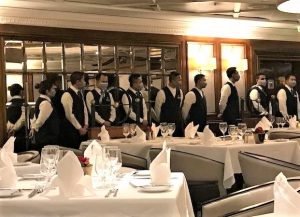 This cruise, and the one that immediately followed, were most unusual, and I seriously doubt that the circumstances surrounding them will ever be quite the same again. I say this because our ship, the Azamara Journey, has the capacity to accommodate 690 passengers. However, there were only 109 on board for our first cruise; 147 for the second. In contrast, there were 408 crew members aboard. I’m sure you get the picture… If you happened to drop a napkin, there would be at least four members of the crew ready to retrieve it for you. Well, not quite…But, in other words, we wanted for nothing. Azamara service, which we have always found to be excellent, was simply superlative (Photo: Waiting to be of service in Discoveries, the Journey’s main dining room. Please note masks.)
This cruise, and the one that immediately followed, were most unusual, and I seriously doubt that the circumstances surrounding them will ever be quite the same again. I say this because our ship, the Azamara Journey, has the capacity to accommodate 690 passengers. However, there were only 109 on board for our first cruise; 147 for the second. In contrast, there were 408 crew members aboard. I’m sure you get the picture… If you happened to drop a napkin, there would be at least four members of the crew ready to retrieve it for you. Well, not quite…But, in other words, we wanted for nothing. Azamara service, which we have always found to be excellent, was simply superlative (Photo: Waiting to be of service in Discoveries, the Journey’s main dining room. Please note masks.)
The low number of passengers, we assumed, was undoubtedly due to concern about Covid. My traveling companion and I were also quite concerned and, after much agonizing, finally decided to go… And we’re both glad that we did, as we never felt safer – either before or after – than we did when we were on the ship. We were tested for Covid both before (as noted above) and during our voyage. Our temperatures were checked each morning, and masks were required in all public areas of the ship. This was true of our various land excursions as well. I can’t speak for other cruise lines, but it was quite evident to us that passengers’ safety was Azamara’s utmost concern… So much for Covid…
Rather than give you a day-by-day ad infinitum, ad nauseam running commentary of our experiences, which had been my original intention, I decided that, in the interests of brevity, I would just touch upon some of the highlights.
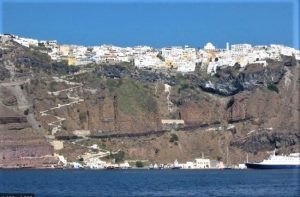 Santorini, Greece: Our cruise got off to a somewhat rocky (literally) start. Our first island stop was to have been a morning arrival at Mykonos, one of the most popular of all the Greek isles. But the sea was too rough to put into port. So, much later in the day, we anchored at Santorini. The view from the deck of our ship – looking up at the 1,000-foot rugged cliffs that form the western flanks of the main island – was truly spectacular (pictured).
Santorini, Greece: Our cruise got off to a somewhat rocky (literally) start. Our first island stop was to have been a morning arrival at Mykonos, one of the most popular of all the Greek isles. But the sea was too rough to put into port. So, much later in the day, we anchored at Santorini. The view from the deck of our ship – looking up at the 1,000-foot rugged cliffs that form the western flanks of the main island – was truly spectacular (pictured).
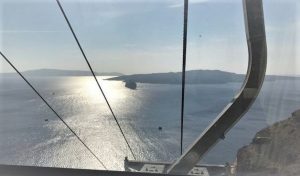 Unfortunately, due to our late arrival – and scheduled departure that evening – the possibilities of exploring the island were severely limited. So, we took the tender craft into the small port of Skala and then the cable car (pictured: our ship, the Azamara Journey, anchored in the bay at Santorini) to Fira (also spelled Thira or Thera), the island capital. The Frommer Guide is absolutely correct when it notes that “Fira surrendered its soul to tourism several decades ago.” Once you depart the cable car, you are confronted with nothing but a plethoric variety of second-rate restaurants and flood of tacky souvenir shops.
Unfortunately, due to our late arrival – and scheduled departure that evening – the possibilities of exploring the island were severely limited. So, we took the tender craft into the small port of Skala and then the cable car (pictured: our ship, the Azamara Journey, anchored in the bay at Santorini) to Fira (also spelled Thira or Thera), the island capital. The Frommer Guide is absolutely correct when it notes that “Fira surrendered its soul to tourism several decades ago.” Once you depart the cable car, you are confronted with nothing but a plethoric variety of second-rate restaurants and flood of tacky souvenir shops.
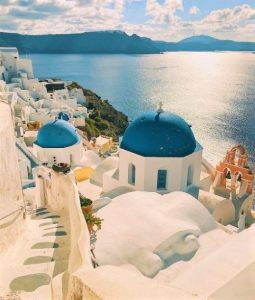 What makes this excursion worthwhile, however, is not only the breathtaking scene from the cable car, noted above, but also the staggering land/seascape that may be viewed from Fira. The cliffside setting and closeup of those picturesque white stone cubical houses with their striking blue domes overlooking the bay are, in themselves, worthy of a journey (pictured).
What makes this excursion worthwhile, however, is not only the breathtaking scene from the cable car, noted above, but also the staggering land/seascape that may be viewed from Fira. The cliffside setting and closeup of those picturesque white stone cubical houses with their striking blue domes overlooking the bay are, in themselves, worthy of a journey (pictured).
And Ammoudi Bay has its own unique story. The bay, some 6 miles long and as deep as 1,312 feet in places, is actually the flooded caldera (crater) of a volcano, whose eruptions caused the center of a once-large island to collapse.
 Patmos, Greece: According to Christian tradition, John the Apostle, brother of James and author of several books of the New Testament portion of the Bible, was exiled to the Isle of Patmos in 95 A.D., where he composed the Book of Revelation. Although biblical scholars are somewhat divided as to whether the John who lived on Patmos and John the Apostle were the same person, his presence – both historical and legendary – still looms large, as the tiny island is regarded as hallowed ground and a place of pilgrimage. A magnificent fortress-like Greek Orthodox monastery, the Monastery of Saint John the Theologian (pictured), was constructed by the monk Christodoulos in 1088 and has remained in continuous operation, surviving raids by Norman pirates in the 11th & 12th centuries and succession of occupiers, including the Germans during World War II.
Patmos, Greece: According to Christian tradition, John the Apostle, brother of James and author of several books of the New Testament portion of the Bible, was exiled to the Isle of Patmos in 95 A.D., where he composed the Book of Revelation. Although biblical scholars are somewhat divided as to whether the John who lived on Patmos and John the Apostle were the same person, his presence – both historical and legendary – still looms large, as the tiny island is regarded as hallowed ground and a place of pilgrimage. A magnificent fortress-like Greek Orthodox monastery, the Monastery of Saint John the Theologian (pictured), was constructed by the monk Christodoulos in 1088 and has remained in continuous operation, surviving raids by Norman pirates in the 11th & 12th centuries and succession of occupiers, including the Germans during World War II.
The monastery is home to numerous treasures: a collection of jeweled chalices, crowns and crosses, ancient transcriptions by Aristotle, and artwork by El Greco. There are also 330 manuscripts housed in the library (267 on parchment), including 82 manuscripts of the New Testament.
The monastery is well worth visiting… Just be aware, however, that the only access is via a steep, winding cobblestoned incline – a strenuous hike even for the physically fit – the last segment of which is lined with tacky souvenir shops all majoring in assorted religious trinkets and paraphernalia. The successive waves of occupiers are nothing compared to the hordes of tourists that annually descend upon this holy enclave.
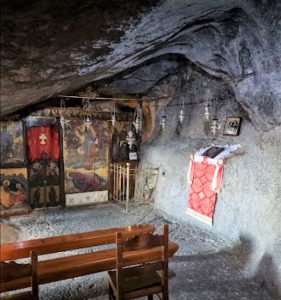 For two years during his exile, John the Apostle made his home in a small cave, now known as the Cave of the Apocalypse (pictured). It was here, it is believed, that he received a series of divine visions, which he then dictated to his disciple, Prochoros, who wrote the messages down utilizing a slope in the cave wall as his desk. According to Christian tradition, these words have come down to us as the Book of Revelation, the last book of the New Testament of the Christian Bible.
For two years during his exile, John the Apostle made his home in a small cave, now known as the Cave of the Apocalypse (pictured). It was here, it is believed, that he received a series of divine visions, which he then dictated to his disciple, Prochoros, who wrote the messages down utilizing a slope in the cave wall as his desk. According to Christian tradition, these words have come down to us as the Book of Revelation, the last book of the New Testament of the Christian Bible.
The cave is now enclosed within a sanctuary, which, in turn, is encircled by chapels and a 17th-century monastic school. Once again, tourists and religious souvenirs abound.
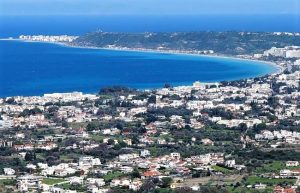 Rhodes, Greece: Our excursion began with a panoramic drive, taking in views of the Acropolis of Rhodes and continuing past the ruins of the amphitheater, stadium, and the temple of Apollo. By the time we reached the excavations of Kamiros, one of the three large Doric cities that united to create the city-state of Rhodes, I was already suffering from the “another day, another ruin” syndrome.
Rhodes, Greece: Our excursion began with a panoramic drive, taking in views of the Acropolis of Rhodes and continuing past the ruins of the amphitheater, stadium, and the temple of Apollo. By the time we reached the excavations of Kamiros, one of the three large Doric cities that united to create the city-state of Rhodes, I was already suffering from the “another day, another ruin” syndrome.
Of far more interest was the sojourn to Mount Filerimos, a plateau 1,000 feet above sea level, overlooking the small town of Lalyssos and the Bay of Ixia and Trianda. From its summit, there is a spectacular view of the harbor below, and beyond, the deep blue waters of the Aegean as it stretches toward the coast of Asia Minor (pictured).
A winding road leads to a relatively wide plateau where the Monastery of Filerimos is located. This site is also of immense archeological importance, as it was here that the
Acropolis of the ancient town of Lalyssos once stood, with an important temple dedicated to Athena Polias (protector of the city).
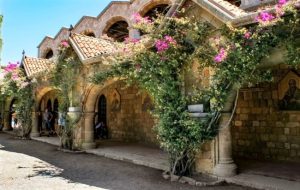 The hill took its name from a monk who came from Jerusalem in the 13th century bearing an icon of the Virgin Mary that was supposedly painted by the Apostle Luke, author of the Gospel and the book of the Acts of the Apostles. The small church he constructed later became a basilica and then, in the 14th century, under the rule of the Knights of St. John, a monastery surrounded by cloisters, cells, and a number of chapels.
The hill took its name from a monk who came from Jerusalem in the 13th century bearing an icon of the Virgin Mary that was supposedly painted by the Apostle Luke, author of the Gospel and the book of the Acts of the Apostles. The small church he constructed later became a basilica and then, in the 14th century, under the rule of the Knights of St. John, a monastery surrounded by cloisters, cells, and a number of chapels.
![]() The icon remained in the monastery until 1523. When the island came into the possession of the Ottoman Turks, the icon was transported by the Knights to France and from there to Italy, and then Malta and Russia, where it stayed until the revolution of 1917. Since 2002, it has been kept in the Blue Chapel of the National Museum of Montenegro, while a copy now resides in the monastery (pictured).
The icon remained in the monastery until 1523. When the island came into the possession of the Ottoman Turks, the icon was transported by the Knights to France and from there to Italy, and then Malta and Russia, where it stayed until the revolution of 1917. Since 2002, it has been kept in the Blue Chapel of the National Museum of Montenegro, while a copy now resides in the monastery (pictured).
The monastery was destroyed during the Turkish occupation; but it was reconstructed in the 1920s by the Italians, who kept it open with monks from the Capuchin Order (a religious order of Franciscan friars within the Catholic Church). When the monks returned to Italy during World War II, the monastery was closed. Today, it remains basically unchanged. A long stairway at the entrance leads up an avenue of cypress trees and bougainvillea to the cloister and the foundations of the temple. The early Christian Basilica and the small subterranean Byzantine church are open to visitors; and the serene setting has become a favorite for wedding ceremonies.
 We were fortunate enough to have an excellent guide who was young (in his twenties), interesting, and well-informed. And one of the facts he mentioned was of particular interest to movie buffs. A number of flicks were filmed on the isle of Rhodes, but none more famous than the 1961 adventure blockbuster The Guns of Navarone, which starred Gregory Peck, David Niven, and Anthony Quinn. The film unit was based on Rhodes from April to July 1960. In fact, Anthony Quinn was so taken with the island that he bought land there in an area that is still called Anthony Quinn Bay. Locations such as Rhodes Harbor, St. Nicholas Bay, Rhodes Medieval City, and the Acropolis of Lindos (pictured) figure prominently in the film.
We were fortunate enough to have an excellent guide who was young (in his twenties), interesting, and well-informed. And one of the facts he mentioned was of particular interest to movie buffs. A number of flicks were filmed on the isle of Rhodes, but none more famous than the 1961 adventure blockbuster The Guns of Navarone, which starred Gregory Peck, David Niven, and Anthony Quinn. The film unit was based on Rhodes from April to July 1960. In fact, Anthony Quinn was so taken with the island that he bought land there in an area that is still called Anthony Quinn Bay. Locations such as Rhodes Harbor, St. Nicholas Bay, Rhodes Medieval City, and the Acropolis of Lindos (pictured) figure prominently in the film.
Day at Sea: A sea day gives passengers a chance to chill out and, since they don’t have to get up early for a shore excursion – catch up on their sleep as well… Or, in my case, catch up on my notes.
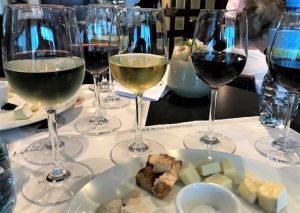 But even on a sea day, there’s plenty going on (sometimes too much) to keep people occupied. At 2:00 p.m., for example, there was a Destination Enrichment lecture by Professor Martin Raish on “Art from Athens’ Golden Age.” We enjoyed several of his excellent lectures… However, on this particular afternoon, there was a conflict. At the very same time as the lecture, the ship’s sommeliers were offering a flavor pairing course entitled “How Food Affects Wine?” I’m sure you can guess which one we attended.
But even on a sea day, there’s plenty going on (sometimes too much) to keep people occupied. At 2:00 p.m., for example, there was a Destination Enrichment lecture by Professor Martin Raish on “Art from Athens’ Golden Age.” We enjoyed several of his excellent lectures… However, on this particular afternoon, there was a conflict. At the very same time as the lecture, the ship’s sommeliers were offering a flavor pairing course entitled “How Food Affects Wine?” I’m sure you can guess which one we attended.
Just to keep our hedonistic tendencies in the proper perspective, however, immediately following the wine seminar, we settled in at Aqualina, the ship’s Italian restaurant, to enjoy the pleasures of afternoon tea.
Limassol, Cyprus: We hopped into a 4×4 and set off on a journey into the Cypriot countryside. Our driver/guide was named Zeus (no, I’m not kidding). Once you leave Limassol, the second largest urban area in Cyprus after Nicosia, the terrain becomes incredibly rugged – imagine the landscape of Mars – punctuated by rambling hills & valleys and quiet little villages.
Following a visit to Kouris, the largest man-made dam on Cyprus, it was a short drive to our next port of call, the tiny village of Lofou, which is named after the hilly landscape that stretches around it like a huge amphitheater. The exact date of the founding of the village is somewhat up for grabs, but it is generally assumed that the first inhabitants settled in during the Arab raids of the 7th century. To escape the Arab attacks, they moved away from the shore, eventually settling in the hills of Lofou.
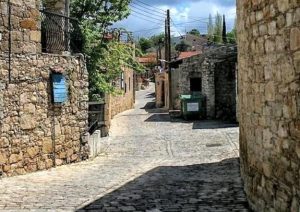 Renowned for its labyrinth of cobblestone streets and beautiful houses constructed of local stone, Lofou is, indeed, a glorious step back in time. Zeus parked out 4×4 on the outskirts, and we descended on foot along a picturesque passageway (photo) into the heart of the village.
Renowned for its labyrinth of cobblestone streets and beautiful houses constructed of local stone, Lofou is, indeed, a glorious step back in time. Zeus parked out 4×4 on the outskirts, and we descended on foot along a picturesque passageway (photo) into the heart of the village.
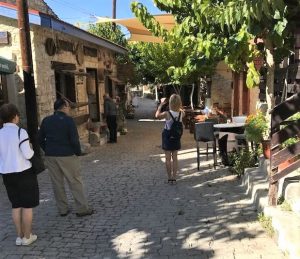 Arriving at the village’s main drag, if you’ll pardon the expression, the members of our group paused for refreshment at the take-out window of the Kamares Taverna. Some indulged in wine or beer. Since it was a bit early in the day for me, I tucked into a rejuvenating shot of double espresso to go with a complimentary pastry. Please note the small table to the right in the photograph… this is where several of us decided to give our weary feet a rest and soak up the unhurried simplicity of a bygone age.
Arriving at the village’s main drag, if you’ll pardon the expression, the members of our group paused for refreshment at the take-out window of the Kamares Taverna. Some indulged in wine or beer. Since it was a bit early in the day for me, I tucked into a rejuvenating shot of double espresso to go with a complimentary pastry. Please note the small table to the right in the photograph… this is where several of us decided to give our weary feet a rest and soak up the unhurried simplicity of a bygone age.
 The taverna interior, however, was even more of a time warp. I had wandered in to use the restroom and was so completely taken with its dimly lit atmospheric recesses – and the older gentleman napping at one of the tables – that I immediately began snapping photographs. As you can readily observe, the rough stone walls are a treasure trove of antiques and family heirlooms with assorted farm implements – remnants of a simpler agrarian age – hanging from the ceiling.
The taverna interior, however, was even more of a time warp. I had wandered in to use the restroom and was so completely taken with its dimly lit atmospheric recesses – and the older gentleman napping at one of the tables – that I immediately began snapping photographs. As you can readily observe, the rough stone walls are a treasure trove of antiques and family heirlooms with assorted farm implements – remnants of a simpler agrarian age – hanging from the ceiling.
My one regret is that we did not have the opportunity to dine here. The restaurant has received excellent reviews and serves traditional and innovative Mediterranean and Cypriot dishes, as well as a wide variety of pastries. From what I gather, Pork in Red Wine and Simmered Lamb are among the house favorites.
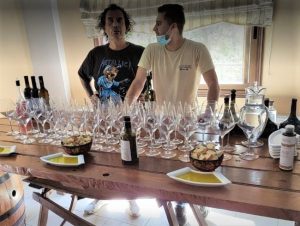 The final stop on our day’s excursion was the Lambouri Winery (pictured: ready for our tasting), considered by many – this writer included – to be the top producer of boutique wines in Cyprus. Located in Platres, a village famous for its winemaking tradition, the estate’s grapes are grown on the island’s finest – and one of Europe’s highest – wine regions, the southern slopes of the Troodos Mountains.
The final stop on our day’s excursion was the Lambouri Winery (pictured: ready for our tasting), considered by many – this writer included – to be the top producer of boutique wines in Cyprus. Located in Platres, a village famous for its winemaking tradition, the estate’s grapes are grown on the island’s finest – and one of Europe’s highest – wine regions, the southern slopes of the Troodos Mountains.
The winery offers a wide variety of vintages, red, white & rosé, dry & sweet. Olympia, produced from the indigenous Lefkada grape, is a medium-sweet red wine; Crimson Sky, on the other hand, is a hefty dry red, an interesting combination of Cabernet Sauvignon and Syrah. White wines include the medium-sweet Zena and delightfully dry Seaside Dream, both produced from the Xynisteri grape. Summer Blush is a very pleasant. dry rosé.
Lambouri’s claim to fame, however, is undoubtedly their Commandaria Legacy. Commandaria is an amber-colored dessert wine produced by local Cyprus grapes Mavro and Xynisteri. It represents an ancient wine style documented in Cyprus as far back as 800 BC by the Greek poet Hesiod. It also has the distinction of being the world’s second oldest named wine still in production, as the name Commandaria dates from the time of the crusades in the 12th century. Richard the Lionheart proclaimed it “The wine of Kings, and the King of Wines.”
A sweet, often fortified, wine made from very ripe sun-dried grapes, Lambouri Commandaria Legacy is aged in oak casks for at least nine years. Intense caramel in color, it is a full-bodied powerhouse on the palate with a long and distinctly raisin-y finish. Trust me, this wine will put hair on your chest.
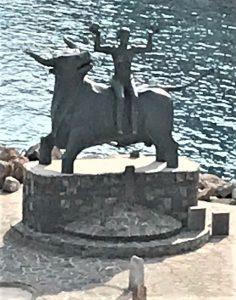 Agios Nikolaos, Crete, Greece: The first thing that caught my eye as our ship docked in Agios Nikolaos was an interesting sculpture at the water’s edge… I discovered that it is a sculpture of Europa riding on a bull. In Greek mythology, Europa is either the daughter of Phoenix or of Agenor, the king of Phoenicia. Her great beauty supposedly caught the eye of Zeus, who approached her in the form of a white bull and carried her away from Phoenicia to Crete. She bore Zeus three sons: Minos, ruler of Crete; Rhadamanthys, ruler of the Cyclades Islands; and, according to some legends, Sarpedon, ruler of Lycia. She later married Asterius, the king of Crete, who adopted her sons. She was worshipped under the name of Hellotis in Crete, where the festival Hellotia was held in her honor… An interesting start to our visit.
Agios Nikolaos, Crete, Greece: The first thing that caught my eye as our ship docked in Agios Nikolaos was an interesting sculpture at the water’s edge… I discovered that it is a sculpture of Europa riding on a bull. In Greek mythology, Europa is either the daughter of Phoenix or of Agenor, the king of Phoenicia. Her great beauty supposedly caught the eye of Zeus, who approached her in the form of a white bull and carried her away from Phoenicia to Crete. She bore Zeus three sons: Minos, ruler of Crete; Rhadamanthys, ruler of the Cyclades Islands; and, according to some legends, Sarpedon, ruler of Lycia. She later married Asterius, the king of Crete, who adopted her sons. She was worshipped under the name of Hellotis in Crete, where the festival Hellotia was held in her honor… An interesting start to our visit.
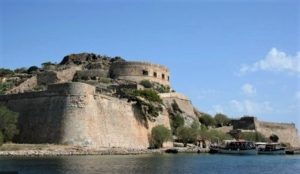 Our shore excursion was to the small fishing village of Plaka. From there we hopped aboard a small wooden boat to the tiny island of Spinalonga. The island was first inhabited by Christians. Sometime later, Venetians constructed an impressive fortress. The island was eventually turned into a leper colony by the Greek state and remained so through the 18th and 19th centuries and even into the 20th century. The last leper left the island in 1957. This was a rather interesting excursion, but our guide was incredibly boring; we spent entirely too much time just standing around listening to her theological discourses.
Our shore excursion was to the small fishing village of Plaka. From there we hopped aboard a small wooden boat to the tiny island of Spinalonga. The island was first inhabited by Christians. Sometime later, Venetians constructed an impressive fortress. The island was eventually turned into a leper colony by the Greek state and remained so through the 18th and 19th centuries and even into the 20th century. The last leper left the island in 1957. This was a rather interesting excursion, but our guide was incredibly boring; we spent entirely too much time just standing around listening to her theological discourses.
Siracusa, Sicily, Italy: Up to this point, we had had nothing but sunshine. Upon our arrival in Sicily, however, it poured; undoubtedly Mother Nature getting even for all those sunny days. The rain was so heavy that all excursions for the day were canceled. It also happened to be my birthday. When we returned from breakfast, we found that the birthday elf had been at work and a big Happy Birthday! sign had been hung in our stateroom. I also received a card from Azamara signed by both the ship’s captain and the hotel director. As I said at the outset… superlative service!
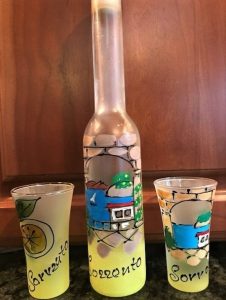 Naples, Italy: Our full day excursion (8 hours) began with a stop at a limoncello factory, where we witnessed how this magical – and exceedingly potent (typically 30% alcohol by volume) – lemon elixir is made and bottled. Samples were freely poured; and, even though it was quite early in the day (about 10:00 a.m.), my sample went down smooth and easy. I could not, of course, leave empty handed. I purchased a beautiful hand-painted bottle along with two matching hand-painted glasses, both of which, even after being emptied, will make a marvelous remembrance of our journey.
Naples, Italy: Our full day excursion (8 hours) began with a stop at a limoncello factory, where we witnessed how this magical – and exceedingly potent (typically 30% alcohol by volume) – lemon elixir is made and bottled. Samples were freely poured; and, even though it was quite early in the day (about 10:00 a.m.), my sample went down smooth and easy. I could not, of course, leave empty handed. I purchased a beautiful hand-painted bottle along with two matching hand-painted glasses, both of which, even after being emptied, will make a marvelous remembrance of our journey.
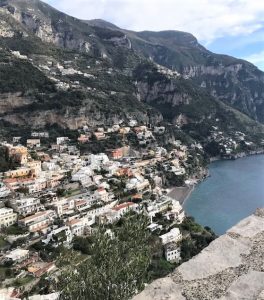 This was followed by a drive along the Amalfi coast, a 34-mile stretch of coastline along the southern edge of Italy’s Sorrentine Peninsula. The view – sheer cliffs and a rugged shoreline awash with beaches and picturesque pastel-colored fishing villages – is, indeed, spectacular. During the high season this route can be choked with traffic, but in the middle/end of November, thankfully, our bus had smooth sailing.
This was followed by a drive along the Amalfi coast, a 34-mile stretch of coastline along the southern edge of Italy’s Sorrentine Peninsula. The view – sheer cliffs and a rugged shoreline awash with beaches and picturesque pastel-colored fishing villages – is, indeed, spectacular. During the high season this route can be choked with traffic, but in the middle/end of November, thankfully, our bus had smooth sailing.
Amalfi itself, which dates back to early Roman rule, is a beautiful city that has managed to preserve its Medieval charm. A stroll along the narrow, shop-filled streets of the historic city lead to the stunning Amalfi Cathedral, a 9th-century Roman Catholic structure in the Piazza del Duomo that is dedicated to the Apostle Saint Andrew.
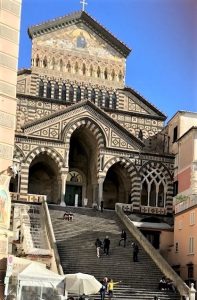 Predominantly of Arab-Norman Romanesque architectural style, the cathedral has been remodeled several times, adding Romanesque, Byzantine, Gothic, and Baroque elements. The front façade was rebuilt in 1891 after the original one collapsed. It is constructed of striped marble and stone with open arches that have lace detailing not commonly found in Italian sacred architecture. Sixty-two wide & deep steps lead up to the bronze doors that were cast in Constantinople before 1066 by Simeon of Syria. The slightly off-center bell tower, constructed between the 12th & 13th centuries, includes four small towers that are adorned with arches and covered with majolica tiles.
Predominantly of Arab-Norman Romanesque architectural style, the cathedral has been remodeled several times, adding Romanesque, Byzantine, Gothic, and Baroque elements. The front façade was rebuilt in 1891 after the original one collapsed. It is constructed of striped marble and stone with open arches that have lace detailing not commonly found in Italian sacred architecture. Sixty-two wide & deep steps lead up to the bronze doors that were cast in Constantinople before 1066 by Simeon of Syria. The slightly off-center bell tower, constructed between the 12th & 13th centuries, includes four small towers that are adorned with arches and covered with majolica tiles.
Civitavecchia (Rome), Italy: End of the first cruise. We stayed on for the second half, as did a number of other passengers. Under normal circumstances, we would definitely have struck out on our own for a tour into Rome. However, because of Italian Government’s restrictions regarding Covid, we were unable to leave the ship on any excursion that was not specifically conducted by our cruise line. So near… yet so far.
Bon Appétit!
Be Safe & Stay Well
TAD


{ 0 comments… add one now }